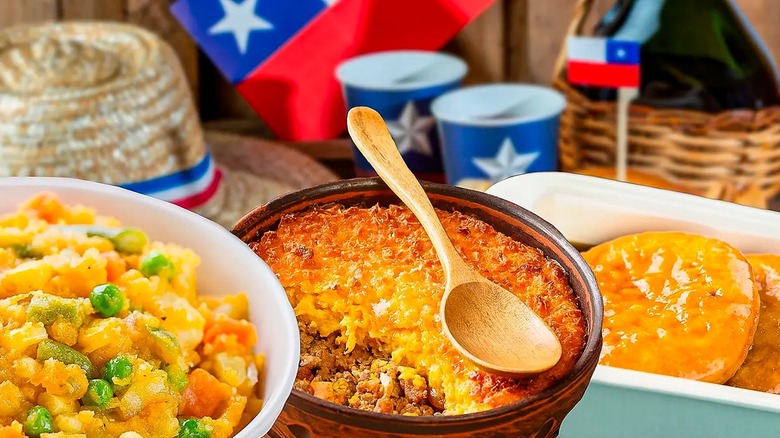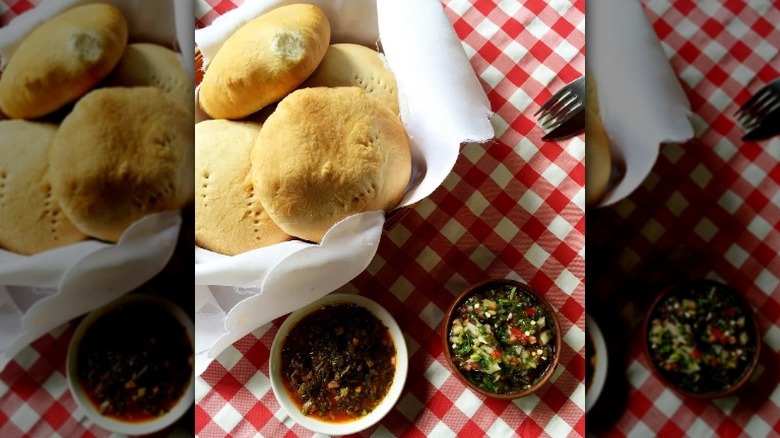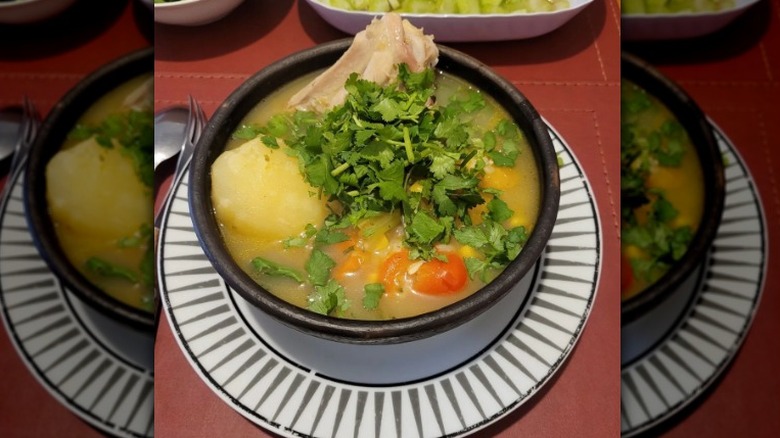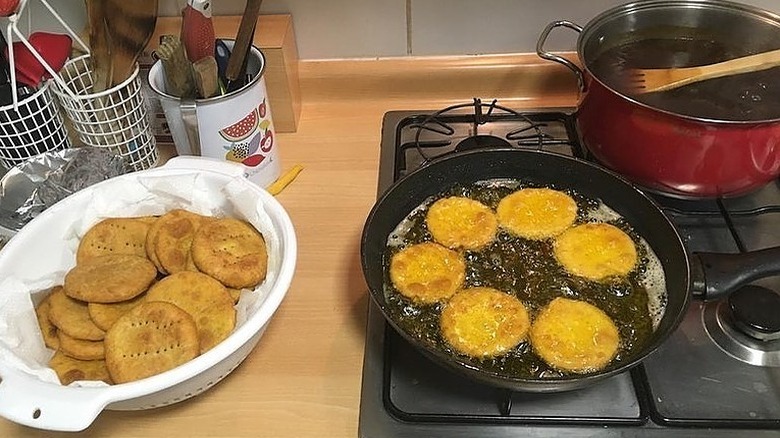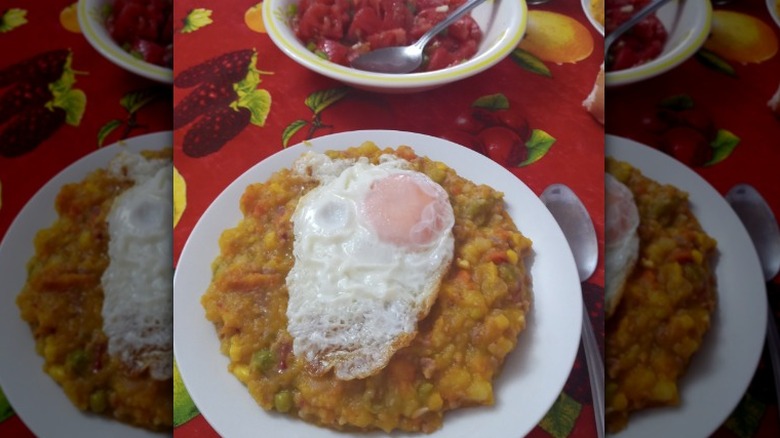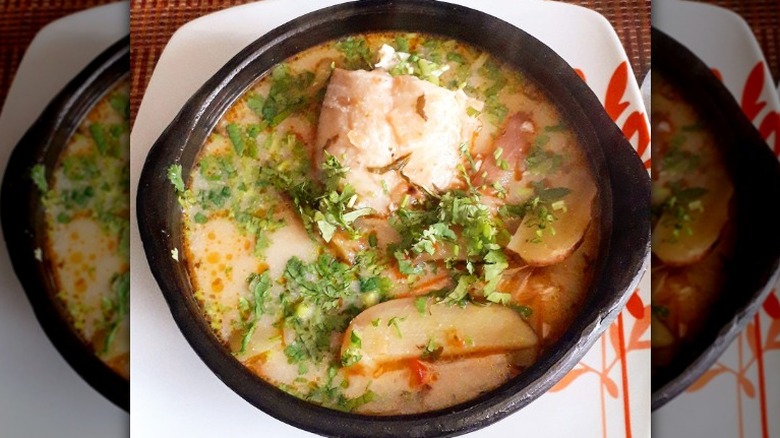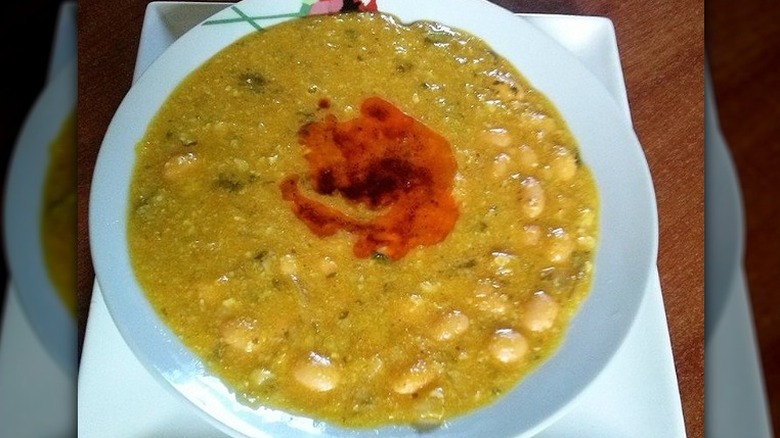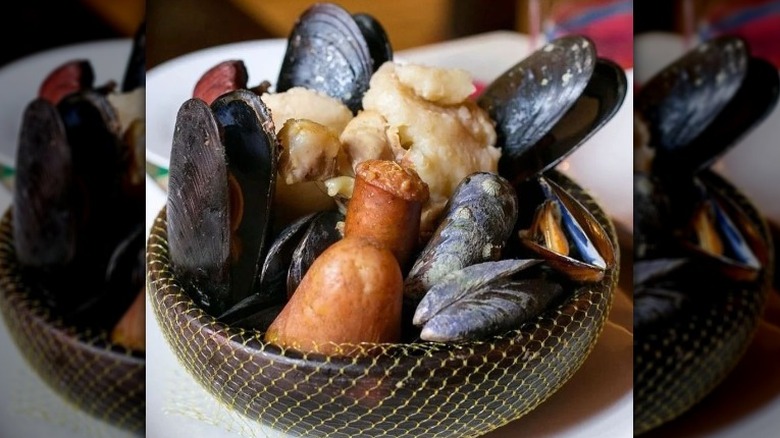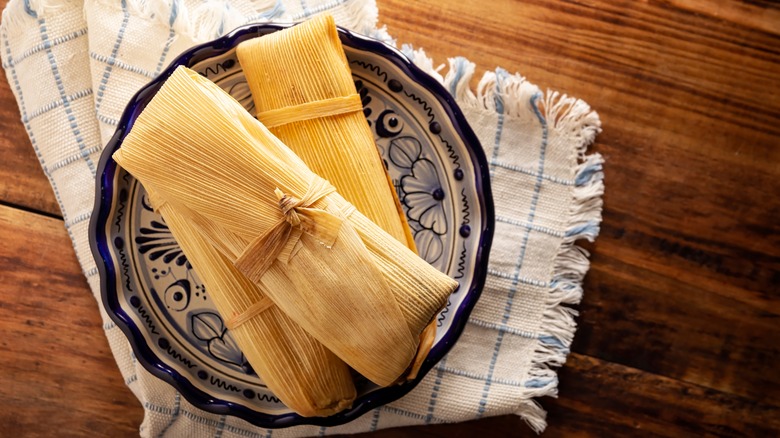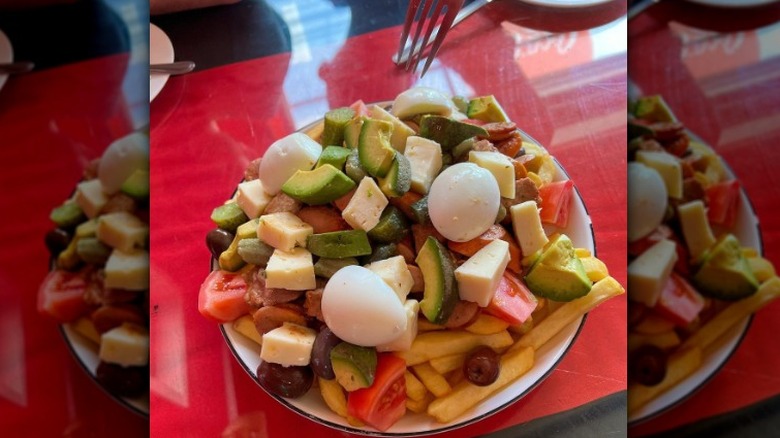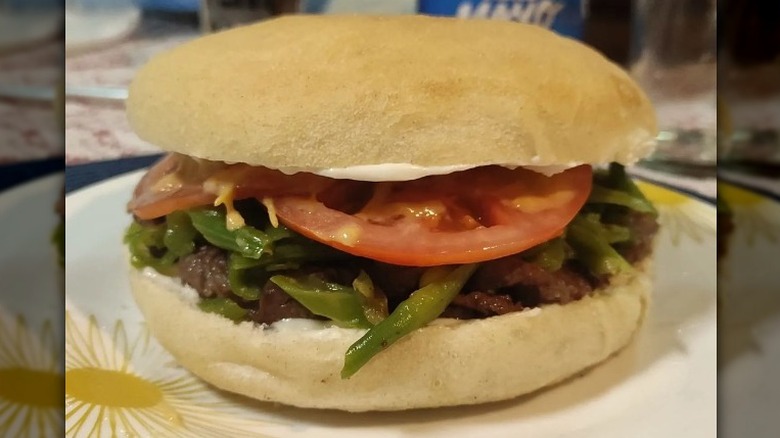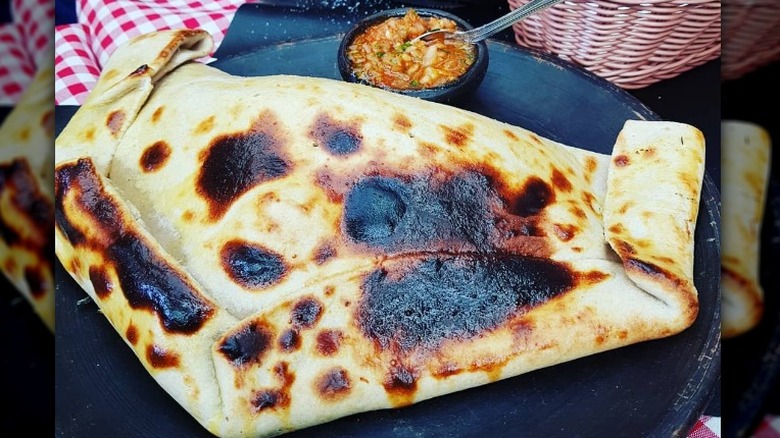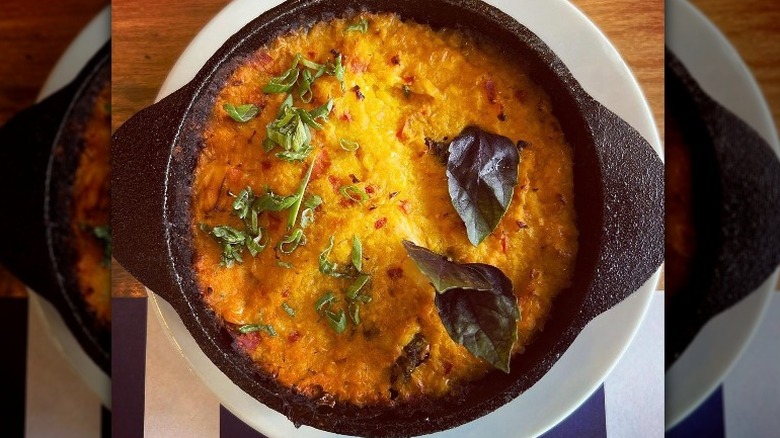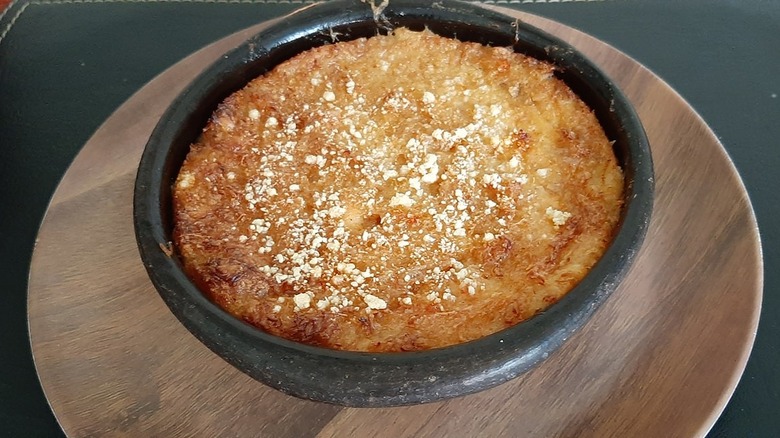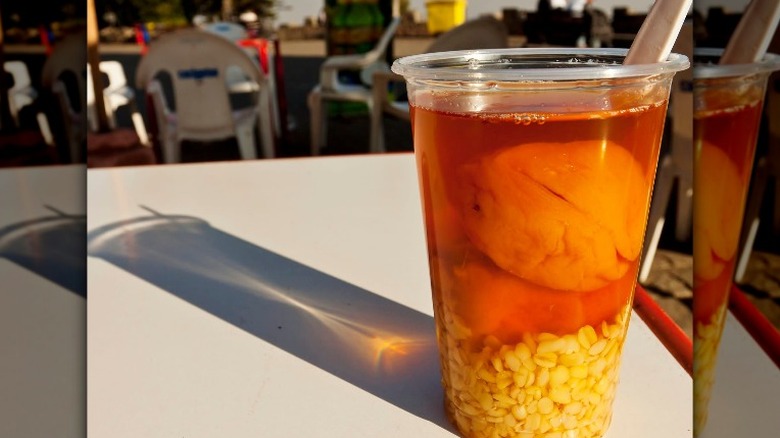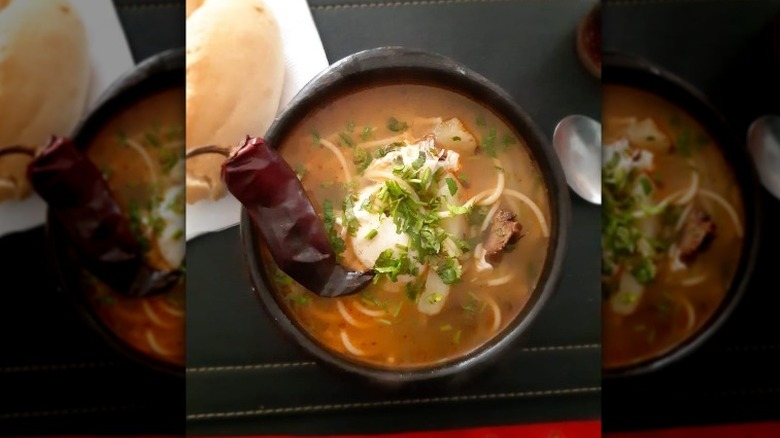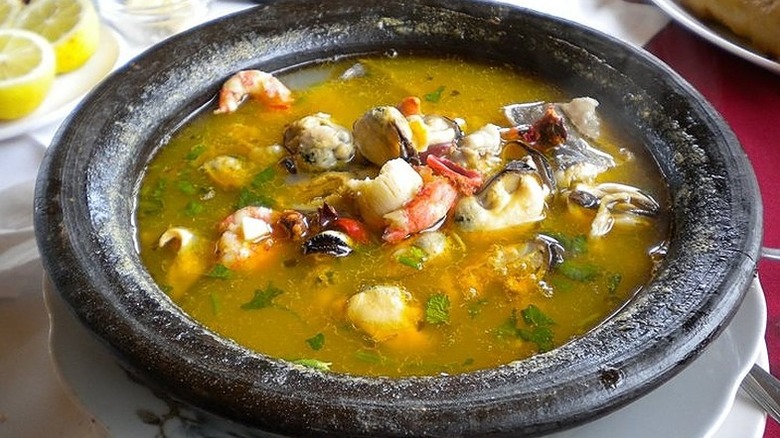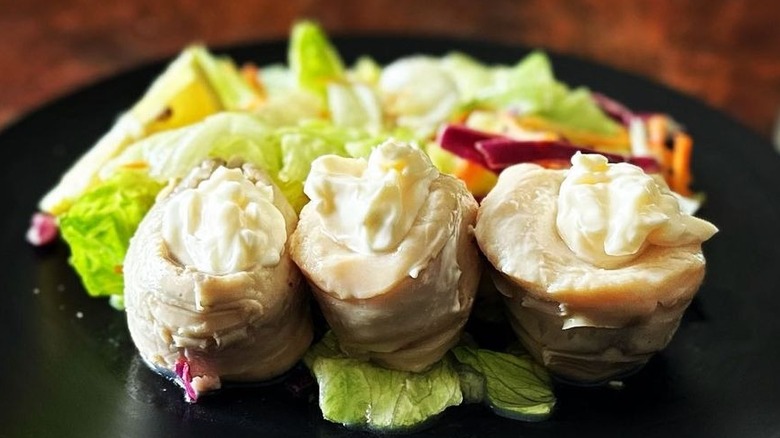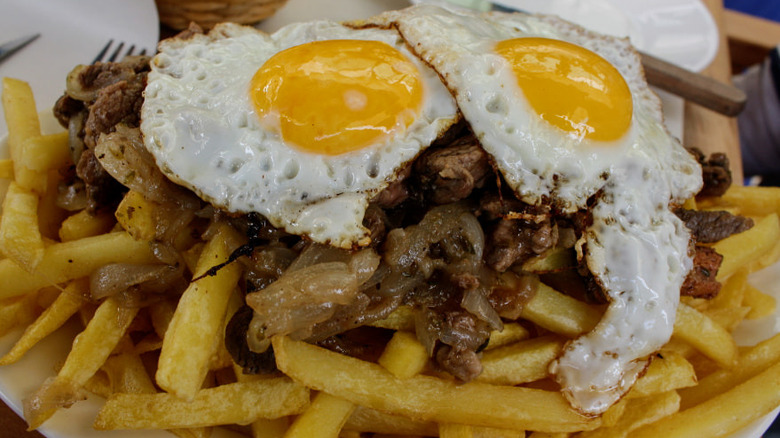20 Chilean Dishes You Need To Try At Least Once
Chile's position in South America offers a wide range of landscapes and influences. With about 2,600 miles of the South Pacific coastline, the Andes separating it from Argentina, the Atacama desert to the north, and Chilean Patagonia to the south, the distinctions are anything but subtle. Aside from the vast variations in geography, the bordering countries also exert an influence.
While these cultural forces are notable across a range of areas, the country's cuisine highlights many of them, too. Seafood specialties, foods cooked over centuries of tradition, and others created in times of necessity all come together under the umbrella of Chilean food. Even if you travel to Chile, it will take you multiple stops across its length to get a broader idea of the wide array. We're outlining the top Chilean dishes you have to try at least once, to pique your interest — and appetite — in this incredibly diverse country.
Pan amasado con pebre
Chances are you're not eating as much bread as the average Chilean — unless you live in Germany. According to a 2019 report by the USDA Foreign Agricultural Service, Chile comes second worldwide for its volume of yearly bread consumption, averaging around 200 pounds per person. If you're on the street before meal times, you'll see people carting bags of bread home to their families.
You'll likely be served the classic duo of pan amasado and pebre upon sitting down at most local restaurants. The bread dough is kneaded and shaped into discs, then commonly baked in a clay oven. The result is a crispy shell with a softer doughy interior. While you could eat it with anything (or even alone), it is often paired with pebre, a salsa-like condiment. The ingredients vary, but you'll usually find a diced blend of tomatoes, cilantro, onions, chili peppers, garlic, olive oil, and vinegar.
Cazuela
Cazuela is the type of dish that inspires people to visit home to savor their mother's cooking. The stew comes in various styles depending on the season, consisting of a lightly seasoned broth, vegetables (corn, potatoes or squash, green beans), and meat (beef, lamb, chicken, or pork are all common). It's the kind of meal that sticks to your bones, warming you up with each spoonful.
Named after the clay casserole it's served in, you will find locals tend to have strong feelings about this traditional dish. Everyone has their favorite versions of it (usually depending on how they grew up eating it at home), and it is absolutely a must-try if you're in Chile, as this dish is deeply engrained in the culture.
Sopaipillas
Although bread is the carb of choice for most Chileans, other starchy foods are savored. Sopaipillas come in various forms in Latin America, but in Chile, they are often made with cooked pumpkin. The squash is mixed with flour, water, a leavening agent, and salt, then shaped into discs and fried. The result is simultaneously crispy and airy, and it's the perfect consistency to scoop up some pebre. Or, you can go the sweet route by sprinkling sugar on top to bring out the pumpkin's natural sweetness.
The tasty recipe is an excellent snack food and a great option to serve as an appetizer. Grab a few at a street-side stand or fry up a batch at home for the ultimate comforting treat. It's no surprise this hearty snack is commonly enjoyed on a rainy day — the hot crispy dough will warm you from the inside out.
Charquicán
Plenty of Chilean favorites consist of variations of meat and potatoes, and, to be fair, the iconic duo is so popular for a reason. It's tasty, nourishing, and satisfies many appetites. Charquicán is a fine example of the duo. Originally made with dried llama or horse meat, ground or shredded beef is more common nowadays. The meat is cooked much like a hash, with potatoes, beans, peas, and corn to fill it out.
Aside from being a savory and filling meal, the reliance on dried meat historically made charquicán popular with nomadic folks, no matter the time of year. Depending on the season, the components vary based on what's available. A fried egg layered on top is always appreciated, enhancing the dish with more protein and flavor.
Caldillo de congrio
When a dish is the star of an ode by the country's greatest poet, Pablo Neruda, you know it's something special. Neruda was onto something, and caldillo de congrio is pretty much the best seafood concoction you'll get in a bowl. The warming dish consists of a broth with conger, a local eel species. If conger isn't available, another white fish is used for the preparation.
The broth is typically red, with stewed tomato, bell pepper, onion, garlic, carrot, and chili pepper. A splash of cream thickens the broth and a fresh sprinkling of parsley and coriander brighten up each spoonful. Commonly eaten with yet more bread, caldillo de congrio is the perfect remedy for a rainy winter day. Or, enjoy it at any time of the year at Santiago's bustling Mercado Central.
Porotos granados
While many classic Chilean dishes rely heavily on animal protein, porotos granados are a welcome vegetarian option. Borlotti (cranberry) beans are the main ingredient, stewed with squash, corn, green beans, tomatoes, and aromatic seasonings. The dish is commonly prepared in the summer when borlotti beans are harvested, however, it can be made in any season with dried beans or other varieties like navy, cannellini, or pinto.
The indigenous Mapuche people were the first to harvest the bean in the south, and this savory stew is one of their most delicious contributions to Chilean cuisine. The various other ingredients were also commonly grown prior to the arrival of the Spanish, making porotos granados a true South American recipe. Serve the creamy stew alone or with a crusty piece of bread.
Curanto
Many cultures have a dish cooked underground, and in Chile, it's curanto. You'll have to travel a bit further than Santiago to get the real deal, though. The Chiloé archipelago sits close to the mainland in the south, yet it can feel like a world apart. Harsh winds and high rainfall are the norms, and the food reflects this rough environment. The dish is easily classified as surf and turf, with a combination of shellfish (mussels, clams), sausage, chicken, potatoes, and potato dumplings.
More important is the preparation; a fire is lit in a pit to heat up stones to cook the various components, though modern recipes cooked in a pot are increasingly prevalent. The ingredients are added and then covered with giant leaves in layers to trap the heat, steaming and infusing them with smoky flavors. The cooked result is loaded into heaping piles on plates, usually in volumes far greater than a single person could consume.
Humitas
Pretty much the Chilean equivalent of a tamale, humitas pre-date Spanish colonization in Chile. Now a snack time and holiday favorite, the indigenous dish is one of few still consumed from this period. Corn is the star ingredient, though a large starchy variety is used for the preparation, providing an earthier flavor than sweet corn.
The corn mixture is commonly enhanced with onion, basil, and merkén — a smoked chili spice common across the country, and one of remarkably few sources of heat in a country whose name would suggest otherwise. Sugar, salt, and milk add flavor and creaminess to the filling. Everything is sealed in corn husks, tied shut, and steamed or boiled. You'll find people who prefer to serve humitas as a sweet dish with cinnamon and sugar, whereas others praise the savory pairing with Chilean salad (tomatoes, onions, and coriander) or pebre.
Pichanga
Plenty of traditional Chilean dishes are warm comfort foods that quickly satiate your hunger. Pichanga, on the other hand, is meant to whet your appetite. The appetizer is a favorite to share with a group, whether you're waiting for your main course at the restaurant, having a few beers at the bar, or hosting friends at home.
Similar to the concept of a charcuterie board, a pichanga is served with all the ingredients jumbled together. Pickled vegetables, olives, avocado, cheese cubes, sausage chunks, and assorted meats are piled onto a plate. Toothpicks make it easy to get what you want, while the salty flavors prepare you for more to come. You can make your own mix or pick up a ready-made selection at supermarkets in Chile.
Completo
Many people consider hot dogs to be the ultimate American food, but Chile's version has its own mass following. The completo has been a sandwich staple for around 100 years and even has its own holiday on May 24. While the inspiration came from the U.S., the South American version took on its own spin. In Chile, street vendors selling hearty dogs are common, and you can buy the meaty bite in sandwich shops or casual restaurants.
The toppings that make it complete (or completo, per its name) include tomato, avocado, sauerkraut, onion, and parsley. The loaded hot dog has numerous variations, notably the Italiano — with tomato, mayonnaise, and avocado — named for the colors of the Italian flag. Other creative garnishes like green beans, fries, scrambled eggs, and melted cheese are among the countless choices, making the completo an incredibly versatile option for a quick meal.
Churrasco
If you're familiar with Brazilian cuisine, you might misleadingly think that Chilean churrasco is also a barbecue event — not quite. In Chile, the term refers to a sandwich, albeit one made with grilled meat. A post on the Chilean tourism website refers to the country as a "sandwich paradise," and a churrasco will likely meet your now-high expectations. Considering Chileans love bread, it's no surprise that a meal that makes use of it is popular.
A churrasco is a steak sandwich, and adding ingredients can quickly modify the name. Top your grilled meat with cheese, and you have a barros luco. Add tomatoes and string green beans (a favorite Chilean topping) and you have a chacarero. Keep it classic with chili pepper sauce or pebre, or load it up with avocado, tomatoes, and mayonnaise, Italiano style.
Empanadas de pino
Most people have tried a version of an empanada (which has quite the history), a wheat flour pocket stuffed with ingredients and then either baked or fried. You can get all sorts of flavors in Chile, including seafood, chicken, beef, and plenty of cheesy variations. Although the origins of the hearty snack come from the Arabic reign in Spain, it made its way to Latin America through colonization.
Each country loads up the dough pouches with its favorite fixings, and, above all, empanadas de pino are the most quintessentially Chilean. The Mapuche people are likely responsible for its components, which include ground beef, onions, raisins, hard-boiled egg, chilis, and a couple of black olives.
Empanadas are so common that you can pick them up at street stands, empanaderias, bakeries, or from locals making extra cash by selling a few dozen a week. While small fried ones are often served as an appetizer in restaurants, heartier appetites will be satisfied by the typical hand-sized versions. Or, hit up the town of Pomaire near Santiago, where empanadas weighing in at over 2 pounds are the main attraction.
Pastel de choclo
A number of Chilean dishes include corn, and pastel de choclo is surely among the most comforting. The corn and meat pie is comparable to a shepherd's pie recipe, and it's a household and restaurant favorite. Its origins date back to Spanish colonization and it's likely related to similar dishes from neighboring countries.
Similarly to the corn used for humitas, pastel de choclo is made with a starchy creamy variety. Sugar is commonly used to sweeten the puréed topping. The meaty base consists of ground beef with onions, along with the ingredients used in an empanada de pino: raisins, sliced hard-boiled eggs, and black olives. The dish is often baked in the oven in traditional clay cookware, infusing it with an earthy flavor.
Pastel de jaiba
Seafood soups and stews are the norms, but Chileans really love when pastel de jaiba is on the menu. The crab casserole is similar to pastel de choclo, with a rich and creamy consistency that begs to be devoured. Blue crab is commonly used for this recipe, and the shredded meat is combined with ingredients like butter, cream or milk, bread, wine, and seasonings.
Similar to other regional oven-baked casseroles, the creamy mixture is cooked in a clay vessel. Bread crumbs and cheese are typically sprinkled on top before a final broil, resulting in a crispy topping that makes every bite even more decadent. Although "pastel" is sometimes translated as "cake," this is a whole new level of crab cake. Enjoy it with local white wine and a simple salad to round off your meal.
Mote con huesillo
It might not be the first combination that comes to mind when you're in the mood for a refreshing drink, but mote con huesillo is a Chilean favorite. The sweet beverage consists of dried peaches cooked in a sugary syrup flavored with cinnamon. The chilled liquid is served with the now-soaked peach (watch out for the pit) and a scoop of cooked and husked wheat kernels.
While both elements have been present in Chilean diets for a few centuries, it is unclear when they came together as mote con huesillo. Nevertheless, the traditional concoction is so typical nowadays that it is even highlighted in a Chilean expression about being so Chilean. Especially in Santiago, the drink is easy to purchase from street vendors across the city. Enjoy it as an afternoon refresher or sip on the syrupy liquid for dessert.
Valdiviano
Named after the coastal city of Valdivia, this dish has a long history backing up its popularity. The story goes that at the end of the 1500s, the Spanish conquistadores were stuck in Valdivia with charqui (dried meat) as their main sustenance. After some time of eating the same salty dried meat every day, they decided to transform it into a new dish.
The dried meat is cooked in a broth with vegetables, onions, boiled eggs, and seasonings (cumin, oregano, and parsley are common). Nowadays, you'll find charqui made from leftover barbecue scraps or with ground meat, but its origin as a dish made with dried meat is unambiguous. Aside from its convenience in difficult times, the hearty soup is also perfect to warm up on a rainy day — all too necessary in Valdivia.
Paila marina
It's no secret that seafood reigns in Chile, in no small part due to its massive coastline. Paila marina brings together all sorts of goodies into a stew — not to be confused with Spanish paella. Typically served in a classic clay bowl, the warm preparation includes various types of shellfish (clams, mussels, shrimp), fish, and a simple seafood stock with carrots, onions, garlic, and seasonings. Tomatoes and bell peppers sometimes end up in the stew, and fresh herb garnishes and a squeeze of lemon juice infuse it with their zesty qualities.
This is another dish that merits a visit to Santiago's Mercado Central, where multiple vendors ladle it out every day. Some people tout its hangover healing properties and visit the market in swarms on January 1, but we'd simply chalk it up to its nourishing and warming nature.
Cordero al palo
Among the dishes from Chilean Patagonia, none receives more attention than cordero al palo. Southern Chile has been home to numerous sheep for over a century, which explains its presence in the local cuisine. Translated as a lamb on a stake, the entire animal is butterflied and mounted on a metal cross or rack.
The meat is roasted vertically on an open wood fire over the course of several hours, producing a richly flavored and smoky result. While the meat cooks, the person tending to the fire continuously bastes it with fat, as well as a mixture of water, salt, clove, and garlic called salmuera. As expected, the meat is typically served with pebre, often with a regional twist. Bread, potatoes, and vegetables fill out the meal, though the true star is undeniably the roast lamb.
Locos
It's pretty easy to find shrimp, mussels, and other types of seafood around the world. Locos, on the other hand, are clearly from the South American nation, as per their alternate name, Chilean abalone. A study by the Universidad de Chile found discarded shells dating back around 10,000 years, which shows that the mollusk was an important part of the local diet at the time. Part of its importance in the cuisine is owed to its abundance of meat, especially compared with other types of seafood.
Nowadays, the meaty mollusk is a rare delicacy, typically served with mayonnaise or a lemon, coriander, and green onion sauce. Additionally, the seafood is baked in a bread, cream, and cheese mixture much like a casserole. Be on the lookout for specialty empanadas showcasing locos, too. If you're planning to cook it yourself, take note that the flesh has to be tenderized first, which traditionally involves pounding it with force.
Chorrillana
Your appetite has to be at a near maximum to even consider ordering chorrillana. The layered bounty of flavors starts with a plate of fries topped with meat (typically chopped beef or sausage), further loaded with grilled onions and either fried or scrambled eggs. Of course, variations with a range of ingredients are common, including cheese, mushrooms, tomatoes, and assorted meats.
Its origins are thought to trace to the port city of Valparaiso, where the gargantuan dish was invented to provide bar-goers with a cheap and hearty meal to soak up all that beer. An order of chorrillana is particularly excessive since it's meant to serve a few people. Gather some friends and a few pints and you'll be cleaning off your plate in no time.
